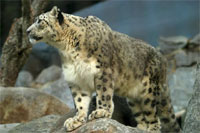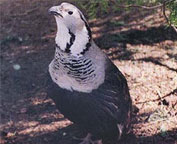Named after the famous monastery Hemis Gompa, the national park spread
out over 600 sq. Km, is situated at Ladakh in J&K. The park known
as the Snow leopard capital of India has an altitudinal range of 3,300
to 6,000 m, and hosts a remarkable variety of wildlife. Hemis was established
as a national park on 4th February 1981. This national park offers the
tourists an abundant treasure of natural beauty with mountains of various
shapes and sizes, mixed with vast flatlands, deserts and bordered by the
fast flowing river Indus.
Hemis occupies much of the catchments of the lower Zanskar
River, from its confluence with the Markha river to its meeting with the
Indus. The smaller northern sector consists of Sumdah Valley which runs
south-east until it meets the main Zanskar Valley. In the southern sector
is the beautiful Markha Valley, also a tributary of the Zanskar Valley,
and the Rumbak Valley which runs eastwards directly into the Indus Valley.
 The
area of this cold desert is rocky and the thin soil cover supports a poor
vegetative growth. Grass growth is relatively rapid during the summer
season after the melting of the snow. The Markha and Rumbak valleys are
high altitude deserts charecterised by sparse grasslands and herbaceous
vegetation on mountain slopes. These areas consists of trees and plants
like Junipers, Myricaria, Poplar, Salix, Birch, Astragalus, Taraxacum,
Leortopodium, Ephedra and many sparse grasslands. The
area of this cold desert is rocky and the thin soil cover supports a poor
vegetative growth. Grass growth is relatively rapid during the summer
season after the melting of the snow. The Markha and Rumbak valleys are
high altitude deserts charecterised by sparse grasslands and herbaceous
vegetation on mountain slopes. These areas consists of trees and plants
like Junipers, Myricaria, Poplar, Salix, Birch, Astragalus, Taraxacum,
Leortopodium, Ephedra and many sparse grasslands.
The National park is famous for its population of the
rare Snow Leopards and the Ibex. The other main species recorded in the
National park are Palla's cat, srapu, bharal, red fox, rhesus macaque,
Hanuman languor, wolf, marmot, Tibetan argali and Ladakh urial etc. The
bharal and urial are seen in large numbers. The park has been earmarked
as one of the snow leopard reserves under a central government project
to conserve the species.
Over 70 varieties of birds are seen in this area. The common
birds are snow cock, chukor, magpie, Himalayan whistling thrush, snow
partridge, golden oriole etc. Some of the less commonly seen birds are
Great Grey Shrike, the Red Mantled Rose Finch, the Black Throated Thrush,
the Robin Accentor, the Spotted Flycatcher, various migrant Teal, the
Red Flanked Blue Tail and the Great Nose Finch.
The climatic conditions vary from sub-arctic to arctic.
Summers are short and mild, rainfall is low and it snows most of the
time. In winter, the temperature drops to far below the freezing point
and the area receives very heavy snowfall, which remains on the ground
for several months at a stretch.
 It
is advisable to only venture into the park with a good guide and also
a rugged vehicle, preferably a 4-wheel drive or a motor cycle.
Camping and trekking are allowed within the park boundaries. The trek
through the beautiful Markha valley with its numerous small villages,
shepherds, camps and passes overshadowed by Kanyatse and other groups
of Peaks is an experience to cherish. Trekkers must be prepared for
extremely cold conditions at all times of the year. It is sensible not
to spend too much time at the mountain passes as excess altitude can
cause medical problems to some people because of lack of oxygen. In
winter, the area is quite inaccessible as the temperature drops down
to below zero. Vehicles are available on hire from local operators in
Leh and Manali. Due to lack of proper infrastructure being prevalent
in the park, it is necessary to make all required arrangements regarding
food, water etc. beforehand. It
is advisable to only venture into the park with a good guide and also
a rugged vehicle, preferably a 4-wheel drive or a motor cycle.
Camping and trekking are allowed within the park boundaries. The trek
through the beautiful Markha valley with its numerous small villages,
shepherds, camps and passes overshadowed by Kanyatse and other groups
of Peaks is an experience to cherish. Trekkers must be prepared for
extremely cold conditions at all times of the year. It is sensible not
to spend too much time at the mountain passes as excess altitude can
cause medical problems to some people because of lack of oxygen. In
winter, the area is quite inaccessible as the temperature drops down
to below zero. Vehicles are available on hire from local operators in
Leh and Manali. Due to lack of proper infrastructure being prevalent
in the park, it is necessary to make all required arrangements regarding
food, water etc. beforehand.
Foreign tourist must check about the latest government
regulations before setting out on this journey.
|

